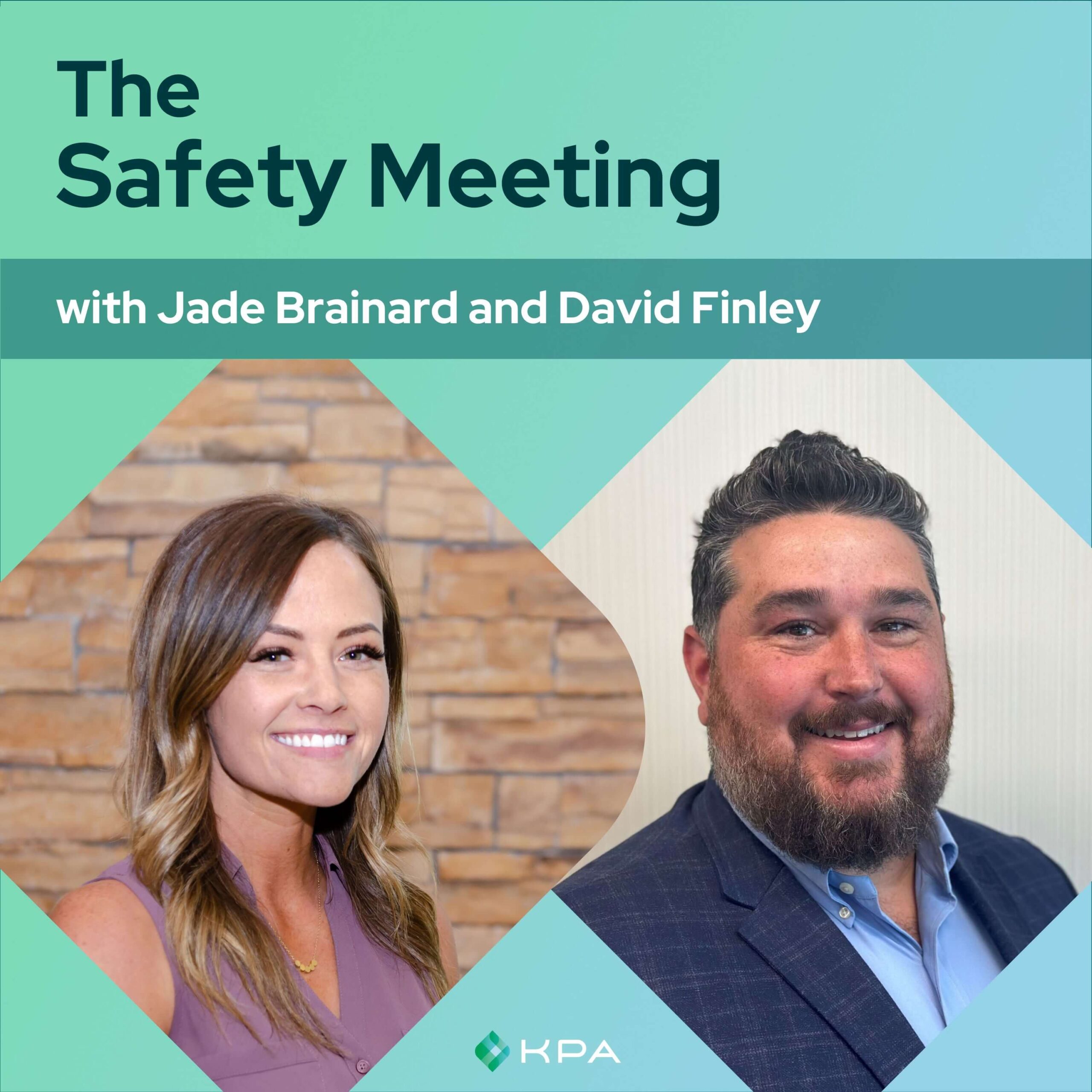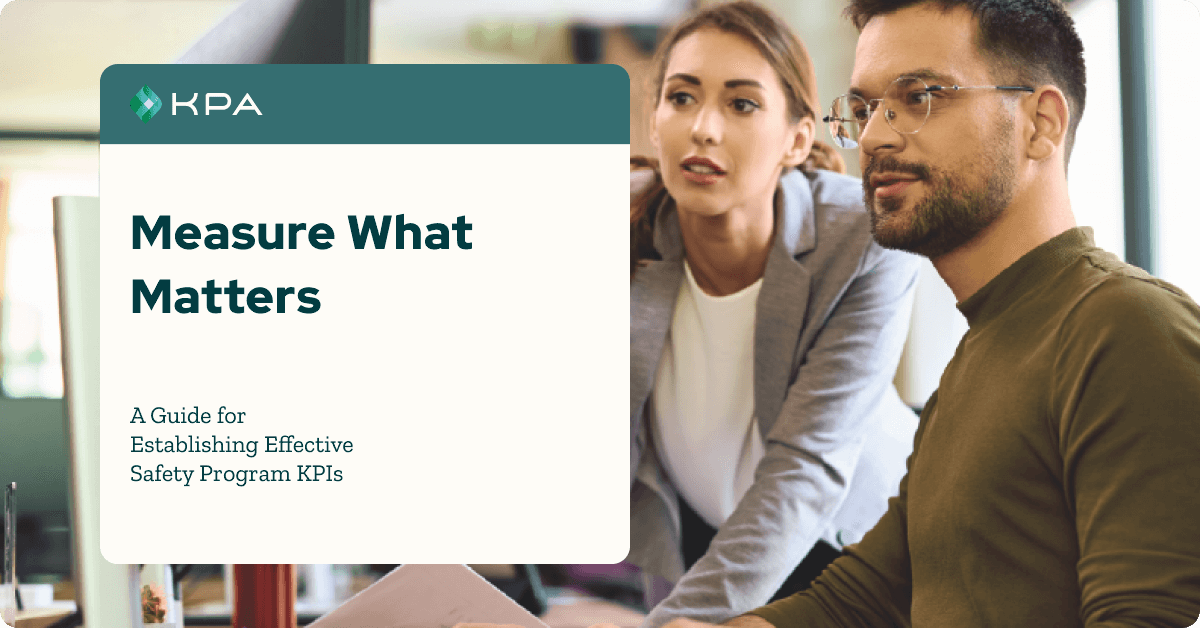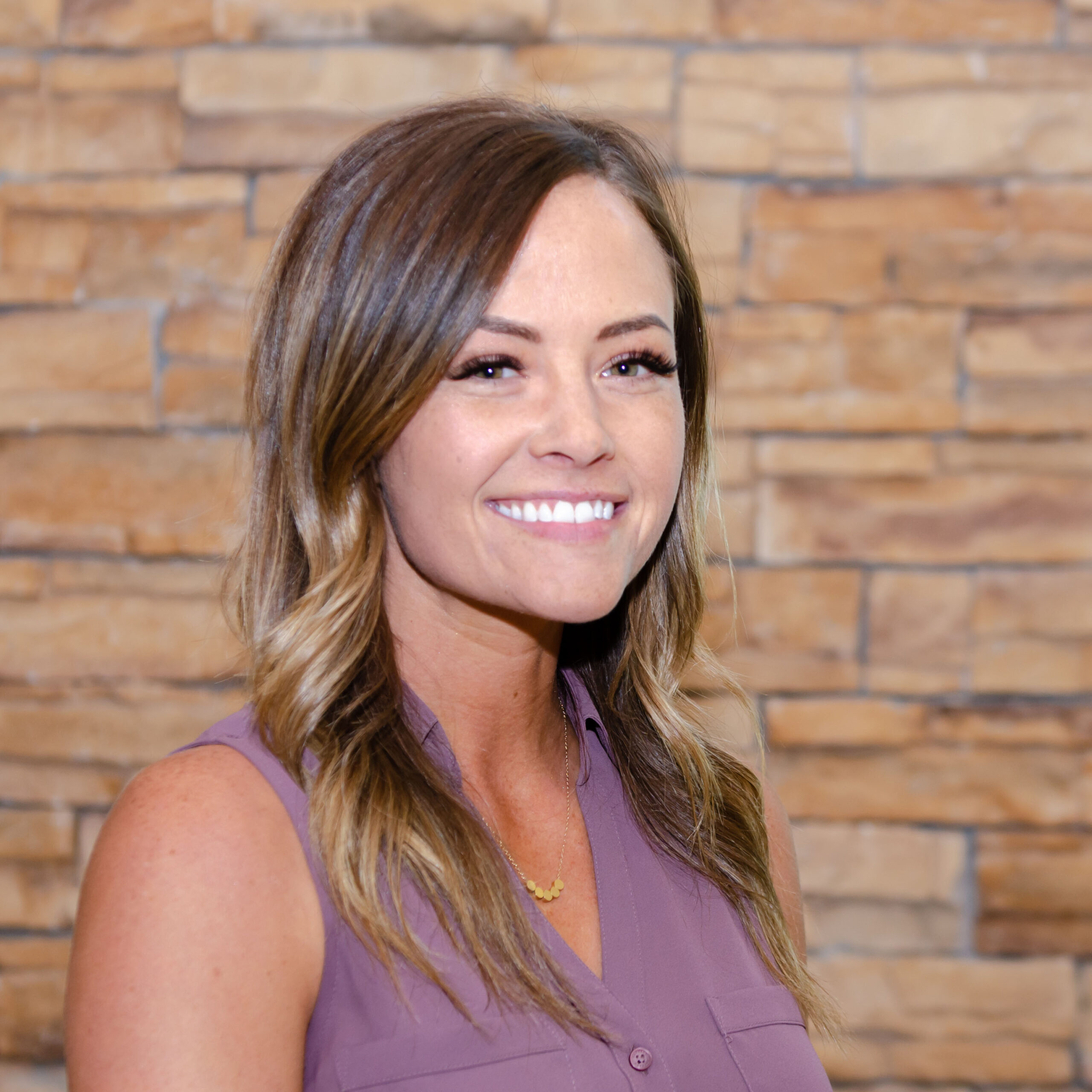
Today we’ll be speaking with two guests, Jade Brainard, KPA’s Senior Director of Product, and David Finley, Dolese’s Director of Health, Safety, and Environmental. Jade is a SaaS technology professional with 14 years of experience in B2B markets, with a passion for solving business problems and achieving customer satisfaction through creative software product solutions.
David has been part of the safety team at Dolese for 15 years and has completely reworked the way the team views safety in the last five years, reducing their IMSHA citations and fostering a proactive approach to safety by tracking the right things in their safety program because we have David with us today who’s an expert on enhancing safety programs with tracking we’re going to be discussing measuring safety metrics. Jade. David, thanks for being with us. Let’s jump in.
When we’re first thinking about safety metrics and KPIs, what are some of the basics that we should be considering? Like what should we be tracking and what do we do with that information once we have it?
Jade:
Before we can even start to identify what are those key performance indicators that are going to be right to track for our organization, it’s what are we trying to achieve? So, we need to identify our objectives.
Do we want to reduce lost time incidents? Maybe we’re having a major issue with the severity of accidents and resulting in people being away from work. Maybe we want to reduce that by x percent. Maybe we want to increase training completion. Maybe we’ve had an issue with training compliance, maybe results in an audit, people not understanding different safety practices. Maybe we want to increase that training participation and completion by a certain percentage. Maybe we want to increase reporting. We want inspections being done. We want near misses being reported.
There’s a lot of different metrics that we can track, but tracking everything might not lead to the results that we’re looking for, or it’s too much. So we need to keep those goals focused, aligning to our objectives. How do we do that, how do we set the right metrics as an organization?
You want to key in on making sure, as an organization, you’re setting smart metrics, ensuring that we have a balanced mix of our leading versus lagging indicators—kind of that age-old concept of safety. We want to make sure we’re not just tracking the reactive measurements but also some proactive measurements. And once we’ve established what the right KPIs to track are, how do we get started?
How do we establish where we’re at today? What information do we have available to us? What information gaps do we have? How do we go and achieve that and fill those gaps? And then once we put the right programs and tools in place, we capture the data. What do we do with all this information that we’re gathering?
So let’s put our data to work. What’s the appropriate review process? What’s our action plan coming out of what we’ve learned, and how do we recognize results and celebrate our achievements and focus on areas where we might still have some work to do?
David:
Jade, you’ve nailed it.
You really have to identify something specific to your company. The objectives and the goals that you want to achieve inside your organization.
You can’t necessarily see what other people are doing and just track the same goals or KPIs as them, because you may not have the same issues or same problems, so you really have to get specific.

Your guide for establishing effective safety program KPIs. As organizations continually strive to improve their safety standards, the role of Key Performance Indicators (KPIs) in shaping an effective safety program is more crucial than ever.
[00:03:41]
I can see what you two are getting at here. Aligning metrics with the actual objectives makes so much sense. If you’re only looking at general examples, you’re not actually going to make an impact in the places where your organization needs help. So in that thread of making sure you’re figuring out what’s going to work for your organization, what are some qualities of a good KPI when it comes to actually starting to track things? What should we be considering?
Jade:
So it’s important to choose KPIs that are smart and smart goals. Smart KPIs are ones that are specific, they’re measurable, they’re achievable, relevant, they’re time-based.
David:
You have to really start with looking at your organization, deciding what’s important, what you need to focus on, and then you have to really start breaking those things down to be specific so that you end up with the outcomes you want.
Jade:
Yeah. And then making sure that it’s measurable. Is this something that we can actually track? Coming back to it being specific: Is this a number that we can look at? Can we look at a total count? Can we trend information over time?
[00:04:50]
Got it. So specific, measurable. Gotta make sure that we’re able to take the data from what we’re tracking and make changes. Is there anything else that’s important when it comes to choosing these KPIs for it to be achievable?
Jade:
We all want a zero-accident culture. We want to send people home in the same or better condition than they arrived, but we do have to make sure that our goals are achievable and set realistic goals based on past performance.
David, would you mind sharing? I know Dolese goes through an annual goal setting process. Can you tell us a little bit more about what that goal setting process looks like and how are those goals achievable?
David:
So we started a larger scale KPI and goal-setting process where we really try to sit down and start as an executive team on an offsite meeting, really looking at: “Okay, where do we have an opportunity to improve?”
And so we’ll look at a really high level across the organization and we’ll get really specific, we may get specific by division, we may get specific by plant. We start talking to the regional operations managers, and then after that we’ll get with the actual site managers and we’ll talk about their performance, and we’ll set some goals and expectations based on past performance.
If we’re at 97% workplace exams submitted during the year, which we can measure, we’ll set a goal. Well, we need to be at 100%, so let’s move up from 97% to 100%. If you’re at 96% on your corrective action, on your near misses and safety concerns, well, let’s now bump that up to 100%.
So we try to create a realistic expectation that’s actually achievable. If you are new to this and you’re just submitting near misses for the first time and you’re getting 0% corrective action and you set a goal for a 100% corrective action, it’s going to be difficult for your team to really buy-in, if they feel like they’re being set up to fail.
And so when we have these meetings and when we look at the KPIs and the goals and metrics, you really need to make sure that you’re setting realistic expectations, so you don’t take away the morale of the plant and make them think they’re not ever going to achieve your goal.
Jade:
We want everyone doing better. So you want it to be achievable, to be obtainable, not setting them up for failure.
So not only do we want to set attainable goals. Also, are they relevant? And is what we’re communicating out regarding performance and and what we’re tracking, does it speak to everyone in the organization, at any level in the organization?
Do they really understand these goals? Do they understand what we’re reporting out, why we’re tracking this?
David:
Yeah, so it has to be relevant when you start making the goal, and you have to keep it relevant to the right people, because if you’re a CEO or A CFO, you really want to make sure that they’re engaged at all times.
We had to figure out a way to keep safety top of mind for all of that executive management group to hold people accountable. And so we want to keep it relevant. And so we were able with KPA to create this report, especially with the near misses and safety concerns.
This goes out weekly to everybody on the executive team and to the different levels of our regional and general managers.
It has pictures, which is always something that draws people’s eyes to a report. If it’s just pages and pages of words, it’s probably going to get passed over. But we’ve added the pictures and just a brief description of the incident and where it was, who turned it in and when it happened, and this has been huge in keeping these relevant and important to the organization.
Jade:
Yep. Too long; didn’t read. Applies to safety reports as well, so yeah, it’s important to capture your audience.
[00:08:47]
Yeah, totally. A giant block of text is ignorable and likely not particularly impactful either, in keeping reports engaging and easy to understand. It’s definitely a key for maintaining interest and accountability among your team.
With what you both detailed here, it’s clear that setting achievable and realistic goals is crucial for keeping everyone motivated and engaged. What are some other qualities of smart KPIs and goals that we should be considering?
Jade:
Yeah, making sure they’re time-based. Having a point in time and tracking this information over time, like, I need to have a benchmark of: “By this date, I’d like to be here.”
Otherwise it can just continue on, and we never really measure our true performance. It also gives some encouragement and incentive to do better, and to encourage reporting, especially if you have the full business involvement. And without having these time-based goals, there’s not going to be a story to tell.
[00:09:41]
That’s a great point, Jade. Having time-based goals really does help to create a clear picture of our progress and keeps everyone motivated. It sounds like tracking performance over time and setting specific benchmarks is key to telling a compelling story of improvement. So now that we’ve done the work to set our smart goals and we’re collecting the data, what do we do with it?
David:
So the first thing you have to do is you have to share it with stakeholders, and those stakeholders are everybody in the organization. You can’t hide any of the data. You can’t just share it with your executive team. You really need to be sharing all of it with everybody so it stays relevant and they’re able to see, to learn from weekly reports, quarterly reports, annual training.
We want to reinforce the behaviors that we want to continue to see, and we also have to recognize trends and take actions. We have to hold people accountable if they’re not actively involved and engaged in what everyone else is doing. Keeping it relevant and keeping people accountable.
Jade:
Yep. Just communicating those results, so making sure that you have those relevant reports. I mean, communicate across the business. Take it a step further like Dolese has done to award positive behavior and set up a recognition program related to safety performance.
[00:10:56]
I see you guys have made it clear that transparency and communication are crucial for making sure everyone in the organization understands and engages with your KPIs and goals.
And it sounds like sharing data openly and reinforcing positive behaviors through recognition programs can really drive accountability and improvement in your teams. I assume that also includes leadership. How do you get leadership buy-in? David, what did you do at Dolese?
David:
When we went to change our culture and go on the safety journey, we had some training with our leadership team and we talked about how they had to be “visibly committed” to safety and to everything that we do.
And we say visibly, we mean actively involved in everything that we do. And that comes down to goal-setting; that comes down to being at the trainings; that’s being at the plant talking about safety with frontline workers. And so really since we made that commitment that we would be visibly committed, that was one of the major selling points to the leadership group, was just understanding that to make this change and to make it work, they had to be there and be involved.
[00:12:07]
That’s a great approach. David, it sounds like being visibly committed has really helped to foster a strong safety culture within your organization. Seeing leadership actively involved and engaged can make a huge difference in how these goals are perceived and achieved by the entire team.
Jade, can you wrap this up with a high-line summary of how to get those meaningful metrics?
Jade:
Yeah, you need to start by identifying what you’re going to track. What do you want to achieve? There’s a lot that we could be tracking. We can’t track everything and we need to have some really key goals that align to our objectives. And now how can we measure that along the way, month to month? We’re not just looking at the end of the year, but how can we measure that we’re headed in the right direction?
So it’s important to choose KPIs that are smart, and smart goals. Smart KPIs are ones that are specific, measurable, achievable, relevant, and time-based. And lastly, communicating those results to facilitate workforce training. Using reporting and dashboards so you can communicate those relevant reports to stakeholders, ESG and sustainability, to cover the breadth of your EHS program.
So it’s measuring what matters and deciding as an organization what key performance indicators are going to be relevant to your business to help improve your safety programs.
[00:13:33]
That’s super insightful. It sounds like focusing on key goals that align with your objectives and ensuring they’re measured consistently is critical. It really ties back into the idea of being specific and relevant, like you said earlier, as well as communicating effectively across the organization.
Thank you both for this conversation today and giving us your insights on the essential qualities of smart KPIs and goals. You both did a great job explaining how focusing on key performance indicators that are specific, measurable, achievable, relevant, and time-based can help orgs to continuously improve their safety programs.
And I know our listeners are always looking for ways to bolster their programs, to make sure their teams get to go home safe every day.
David:
Thank you for this opportunity.
Jade:
Thank you.
Related Content
Explore more comprehensive articles, specialized guides, and insightful interviews selected, offering fresh insights, data-driven analysis, and expert perspectives.

